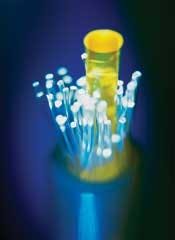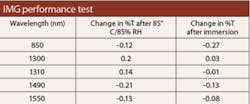Though misconceptions persist, no-epoxy/no-polish fiber-optic connectors perform well, thanks to improved IMG performance.
by Ray Barnes
As fiber-optic cable is increasingly deployed in both private and public networks applications, including FTTx, the need to install connectors in the field continues to grow. Due to the installation speed, reduced setup/teardown time, deployment velocity and convenience, and dramatic labor savings, adoption of no-epoxy/no-polish (NENP) connectors for field termination has shown a significant increase.
NENP connectors use a factory-polished connector endface in conjunction with a mechanical splice to provide seamless connectivity. The reliability and performance of the mechanical splice within the connector is enhanced through the use of silicone-basedindex matching gel (IMG), which is formulated to have an index ofrefraction (IOR) that closely matches the IOR for the glass used in opticalfibers. In addition, the physical properties of IMG are carefully controlled to ensure optimum performance.
Using IMG allows for greater variation in field cleaves while eliminating the need forfusion-splice equipment or extensive training. In these ways, NENP connectors using IMG are enabling true copper-like optical-fiber subscriber connections.
IMG past and present
IMG has been an integral part for mechanical optical-fiber splicing and termination for more than 30 years. Despite the historical and market-based confirmation of IMG as a viable enhancement for mechanical splice products, there are several misconceptions based on gel formulations used up until the early 1990s that were not as carefully controlled as IMG formulations used today.
For comparison, the table “Changes to IMG performance parameters” (page 22) shows the changes to performance parameters of past and present IMG formulations used in mechanical splices and NENP connectors.
The performance parameters of today’s optical gel have improved markedly over gels used as recently as the early 1990s. Fluid separation and evaporationparameters are 5x and 10x better, respectively. In addition, percent transmittance (%T) has been improved from 79% to 97%.
Clarity and optical transmission
Optical clarity of IMG is measured as the percentage of light transmitted through a 1-cm path-length gel sample. In tests, the percent transmitted was measured before and after a heat-aging process in which the gel was heated to 80º C for a period of 136 days. The table “80° C heat aging for 136 days” (page 22) shows change in %T at the wavelengths commonly used in data-communications and FTTx networks.
The decrease in the amount of light transmitted is very small. Additionally, the path length in a typical mechanical splice would be about 10 µm—1,000x shorter than the path length of 1 cm used in the test. If decibel loss were calculated for the values of % T given, the losses would be in the ten-thousandths of a decibel. This is well beyond the measurement capability of available test equipment, which may only measure to the hundredths of a decibel.
Another concern is how the IMG’s clarity is affected over the normal operating temperature range of -40º to +70º C.Recent testing of IMG used in NENP connectors has confirmed that IMG undergoes virtually no change in the percentage of light transmitted at temperature extremes. The table “Test results in %T” (page 25) shows the test results in terms of change in %T with respect to room temperature (RT). As shown, excellent performance can be expected across a wide temperature range when using IMG.
Gel retention in mechanical splice
Another misconception about IMG is the belief that the gel will liquefy over time or at temperature and leak out of the connector or splice. Gel retention in mechanical splices and connectors, however, is ensured through careful control of fluid separation and apparent viscosity.
First, fluid separation (or “bleed”) refers to oil that separates from the IMG over time or at extreme temperatures. Excessive fluid separation could lead to the oil running out of themechanical splice. Past formulations have been tested and found fluid separation values as high as 2%, contributing to the misconception that gel may leave the splice by leakage. The IMG used in modern NENP connectors and splices, however, is formulated to exhibit less than 0.2% fluid separation during a 24-hour heat soak at 100º C—the boiling point for water—which means that IMG will not leak out of the mechanical splice or connector over time or temperature.
Apparent viscosity is another carefully controlled physical property of IMG that prevents the gel from leaking out of the connector. IMG is a thixotropic gel, which means it can flow when subjected to high shear, such as during dispensing from a syringe. On the other hand, when the gel is at rest between two fiber endfaces in a mechanical splice, the apparent viscosity is very high. In fact, the apparent viscosity is like that of gum rubber.
With low fluid separation, high apparent viscosity, and splice designs that com-pletely enclose and encapsulate splice parts, tests show the IMG used in modernmechanical splice applications will not leak, wick, or otherwise leave the optical splice.
Gel hardening factors
Four key physical characteristics determine whether a gel will harden or crystallize:
- Fluid separation;
- Evaporation;
- Thermogravimetric stability;
- Glass transition temperature.
Modern IMG used in NENP connectors is designed to have virtually no fluid separation. In addition, the IMG exhibits very low evaporation. During a test at 100º C for 24 hours, the gel exhibited less than 0.1% mass loss due to evaporation.
At low and high temperature extremes, the main concerns are glass transition temperature (Tg) and thermogravimetric stability, respec-tively. The Tg is essentially the temperature at which a liquid or gel starts to freeze or becomes a solid. For IMG, the Tg is -59ºC. The mostdemanding applications in optical connections only require the connectors to withstand temperatures to -40º C.
At the other end of the temperature extreme, IMG exhibits very good thermogravimetric stability at high temperatures.In tests, the thermogravimetric takeoffpoint (the point at which there was mass loss of 1% due to evaporation and chemical oxidation) was measured to be279º C. Modern IMG is designed and tested so that it willremain in a stable gel state throughout the service life ofthe optical device.
Particle contaminants
Another common concern is that the IMG used in an optical connector or splice may become contaminated. During manufacturing, IMG goes through a series of processing steps to ensure optimum performance with respect to particle contamination. For this reason, initial particle contaminants are non-existent.
While initial particle contaminants are insignificant, some are concerned that IMG will attract dust particles from the air. But manufacturers prevent this from happening by dispensing IMG into theoptical device in a cleanroom-typeenvironment. During handling prior to installation, the IMG is contained inside the device and protected from exposure by the use of dust caps.
Additional protection against dust particles is provided by the use of active alignment systems incorporated into installation tools. These systems give installers a go/no-go indication that the fiber is properly installed. With these active alignment systems, should a particle of dust get between the fibers in an optical device, the connector-installation tool would give the installer the opportunity to re-clean, re-cleave and re-insert the fiber. Once the connector or device has been activated, even if the particle has been introduced to the gel, due to the high apparent viscosity, the particle will not migrate.
What about liquid contaminants?
There is also concern that water or other liquids may migrate or diffuse into the IMG at the splice, degrading performance. Several factors the severity of potential migration, including duration of immersion, presence of solvents in the liquid, and the containment of the gel-filled splice.
A recent study by a leading IMG manufacturer measured the performance of IMG when exposed to an 85º C/85% relative humidity (%RH) test and an immersion test. The test measured initial %T, %T after exposure to 85º C/85%RH for seven days, and %T after seven days of immersion in de-ionized water. The gel-path length for the tests was1 cm. Results of the test are given in the table “IMG performance test” (left).
The test data shows practically no change in %T withrespect to the tests conducted, and proves that liquid contamination will not limit the service life of IMG inchallenging FTTx applications.
Service-life study
Many doubts about IMG concern the material’s service life when used in optical devices. Naturally, products designed for communication purposes should last for decades rather than years. To understand the usable service life of IMG, studies using gravimetric analysis have been conducted by both IMG and component manufacturers. To calculate service life for the IMG; it was found the service life of the gel to be 203 years at 40º C.
Another study, by a leading gel manufacturer, placed an IMG sample at 80º C for 136 days. Based on the findings, the study found a half-life of 14.6 years or a full life of 29.2 years at 80º C. It should be noted that these temperatures are well above room temperature, which is 25º C. Based on the studies, it is easy to see that IMG will allow components to providedecades of service.
The optical-components market hasaccepted IMG technology, since virtually every major component manufactureroffers products that use IMG to enhance optical performance. From mechanical splices to NENP connectors, there is a wide selection of products and competitors from which to choose. With growing bandwidth demand and acceleration of FTTx deployments to meet that demand, IMG will prove to be an enabling technology. With 30 years of innovation and improvement, the IMGs used today are vastly superior to earlier formulations.
Extensive testing has proven the reliability of IMG over a wide temperature range, at a wide variety of wavelengths, and for extended periods of time. With the enhanced performance offered by IMG, as well as initial tooling and installation-cost reductions, optical components using IMG haveproven that they are not only here to stay but, in fact, are leading the way.
(This article originally appeared in the January issue of our sibling publication, Connector Specifier.—Eds.)
RAY BARNES, P.E., ([email protected]) is senior applications engineer at Corning Cable Systems.





